EXPRESSIVE MEANS AND STYLISTIC DEVICES Structure


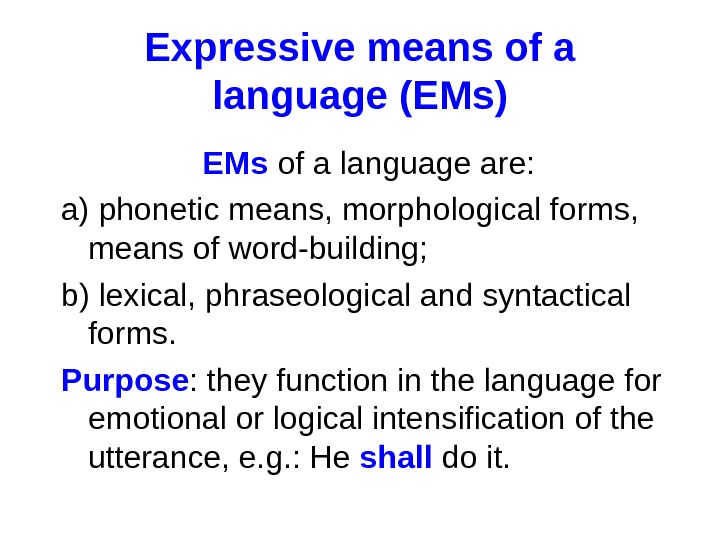


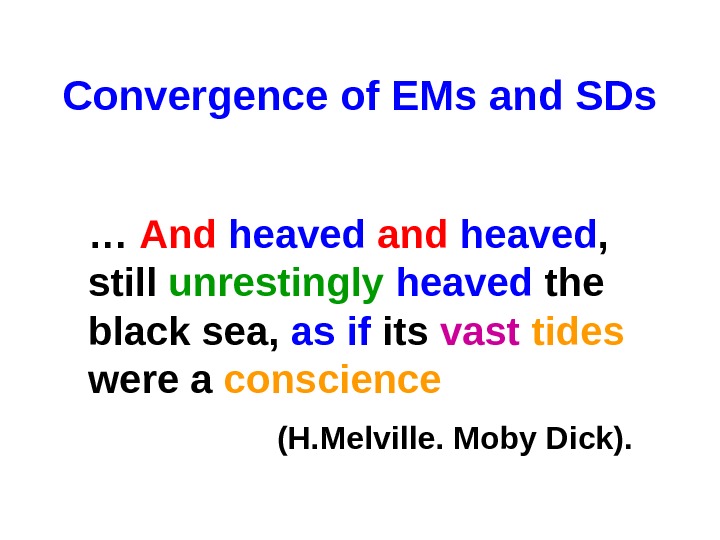
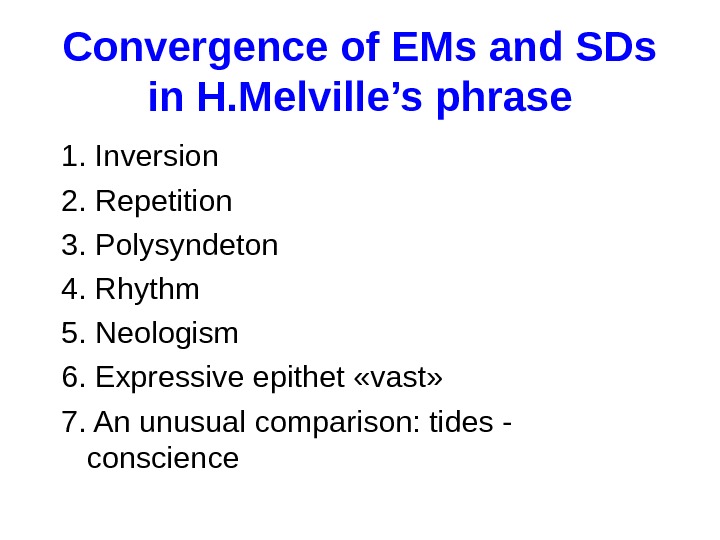
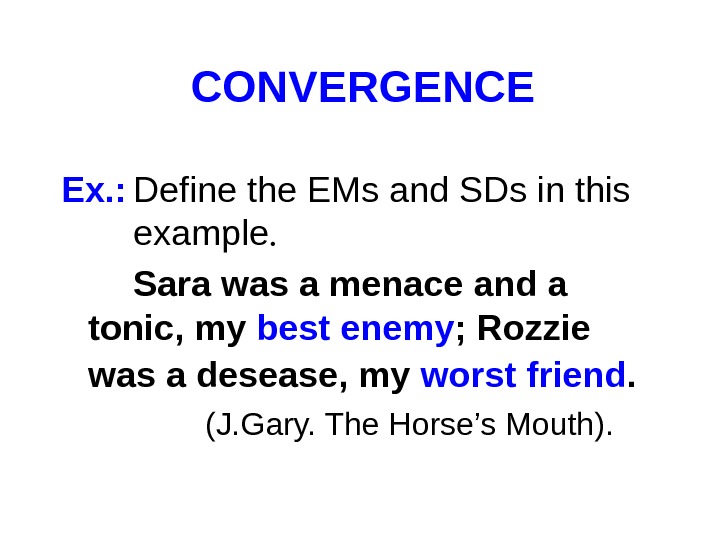






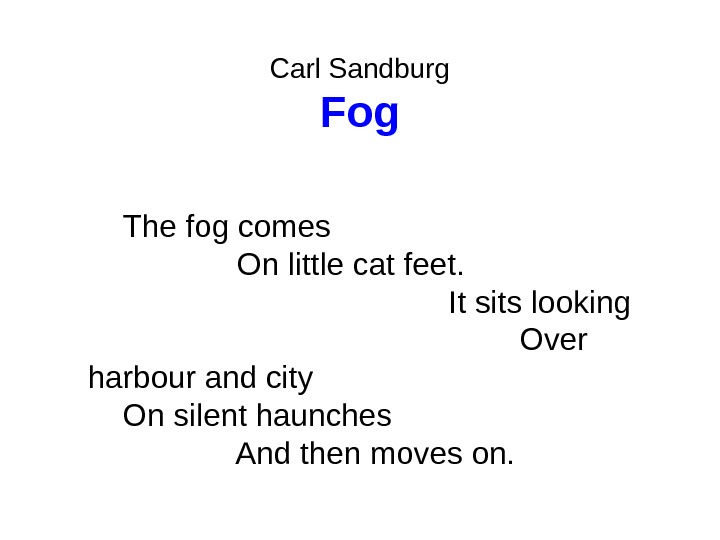

4_expressive_means_and_stylistic_devices.ppt
- Размер: 35.5 Кб
- Количество слайдов: 16
Описание презентации EXPRESSIVE MEANS AND STYLISTIC DEVICES Structure по слайдам
 EXPRESSIVE MEANS AND STYLISTIC DEVICES Structure and functions
EXPRESSIVE MEANS AND STYLISTIC DEVICES Structure and functions
 Transference the act of name exchange, of substitution The name of one object is transferred onto another on the basis of: a. their similarity (of shape, color, function, form, etc. ); b. Their closeness (of material existence, cause and effect, instrument and the result, part and whole relations, etc. ).
Transference the act of name exchange, of substitution The name of one object is transferred onto another on the basis of: a. their similarity (of shape, color, function, form, etc. ); b. Their closeness (of material existence, cause and effect, instrument and the result, part and whole relations, etc. ).
 Expressive means of a language (EMs) EMs of a language are: a) phonetic means, morphological forms, means of word-building; b) lexical, phraseological and syntactical forms. Purpose : they function in the language for emotional or logical intensification of the utterance, e. g. : He shall do it.
Expressive means of a language (EMs) EMs of a language are: a) phonetic means, morphological forms, means of word-building; b) lexical, phraseological and syntactical forms. Purpose : they function in the language for emotional or logical intensification of the utterance, e. g. : He shall do it.
 What is a stylistic device? A SD — is a conscious and intentional literary use of some facts of the language (including expressive means ) with the purpose of further intensification of the emotional or logical emphasis contained in the corresponding expressive means.
What is a stylistic device? A SD — is a conscious and intentional literary use of some facts of the language (including expressive means ) with the purpose of further intensification of the emotional or logical emphasis contained in the corresponding expressive means.
 Examples of SDs a) Andrew’s face looked as if it were made of a wrotten apple (simile). b) She gave him her best go-to-hell look (phrase epithet). c) Her family is one aunt about a thousand years old (hyperbole). d) I looked at the gun , and the gun looked at me (chiasmus).
Examples of SDs a) Andrew’s face looked as if it were made of a wrotten apple (simile). b) She gave him her best go-to-hell look (phrase epithet). c) Her family is one aunt about a thousand years old (hyperbole). d) I looked at the gun , and the gun looked at me (chiasmus).
 Convergence of EMs and SDs … And heaved and heaved , still unrestingly heaved the black sea, as if its vast tide s were a conscience (H. Melville. Moby Dick).
Convergence of EMs and SDs … And heaved and heaved , still unrestingly heaved the black sea, as if its vast tide s were a conscience (H. Melville. Moby Dick).
 Convergence of EMs and SDs in H. Melvill e ’s phrase 1. Inversion 2. Repetition 3. Polysyndeton 4. Rhythm 5. Neologism 6. Expressive epithet «vast» 7. An unusual comparison: tides — conscience
Convergence of EMs and SDs in H. Melvill e ’s phrase 1. Inversion 2. Repetition 3. Polysyndeton 4. Rhythm 5. Neologism 6. Expressive epithet «vast» 7. An unusual comparison: tides — conscience
 CONVERGENCE Ex. : Define the EMs and SDs in this example. Sara was a menace and a tonic , my best enemy ; Rozzie was a desease , my worst friend. (J. Gary. The Horse’s Mouth).
CONVERGENCE Ex. : Define the EMs and SDs in this example. Sara was a menace and a tonic , my best enemy ; Rozzie was a desease , my worst friend. (J. Gary. The Horse’s Mouth).
 Check yourselves 1) Parallel constructions. 2) Antithesis: enemy-friend , worst — best. 3) Antonymical metaphors: tonic — desease. 4) Violation of usual combinability: instead of best friend we read best enemy , worst friend Stylistic function : deep contradictory rela-tions inside a love triangle are portrayed.
Check yourselves 1) Parallel constructions. 2) Antithesis: enemy-friend , worst — best. 3) Antonymical metaphors: tonic — desease. 4) Violation of usual combinability: instead of best friend we read best enemy , worst friend Stylistic function : deep contradictory rela-tions inside a love triangle are portrayed.
 Phonetic EMs 1. Onomatopoeia — murmur, hiss, bump, etc. 2. Alliteration — «And the s ilken, s ad, un c ertain ru s tling of each purple curtain. . . » (E. Poe. The Raven). Stylistic function: authentic live communic- ation, the informality of speech acts: lemme, mighta, coupla. . .
Phonetic EMs 1. Onomatopoeia — murmur, hiss, bump, etc. 2. Alliteration — «And the s ilken, s ad, un c ertain ru s tling of each purple curtain. . . » (E. Poe. The Raven). Stylistic function: authentic live communic- ation, the informality of speech acts: lemme, mighta, coupla. . .
 Phonetic E M s -2 3. Graphon: a) «Yetalians» , «peerading» (parading). b) stumbling: N-n-nice weather, isn’t it? c) lisping: You don’t mean to thay that thith your firth time… Stylistic function: authentic live commu-nication and speech characteristization.
Phonetic E M s -2 3. Graphon: a) «Yetalians» , «peerading» (parading). b) stumbling: N-n-nice weather, isn’t it? c) lisping: You don’t mean to thay that thith your firth time… Stylistic function: authentic live commu-nication and speech characteristization.
 METAPHOR A SD based on similarity
METAPHOR A SD based on similarity
 What Is a Metaphor? A metaphor is a relation between the dictionary and contextual logical meanings based on the affinity (similarity) of certain properties (traits ) of two corresponding concepts. I. V. Arnold qualifies metaphor as concealed simile. Compare: a) You are my angel. b) I hear your voice — it’s like an angel’s sigh.
What Is a Metaphor? A metaphor is a relation between the dictionary and contextual logical meanings based on the affinity (similarity) of certain properties (traits ) of two corresponding concepts. I. V. Arnold qualifies metaphor as concealed simile. Compare: a) You are my angel. b) I hear your voice — it’s like an angel’s sigh.
 The Structure of a Metaphor A metaphor consists of the following parts: 1) tenor (the thing/object or person denoted); 2) vehicle (the object with which comparison is made); 3) the ground (basis for comparison, the commonness) [ I. V. Arnold]. E. g. : He is a snake. The doctor wrapped himself in a mist of words.
The Structure of a Metaphor A metaphor consists of the following parts: 1) tenor (the thing/object or person denoted); 2) vehicle (the object with which comparison is made); 3) the ground (basis for comparison, the commonness) [ I. V. Arnold]. E. g. : He is a snake. The doctor wrapped himself in a mist of words.
 Carl Sandburg Fog The fog comes On little cat feet. It sits looking Over harbour and city On silent haunches And then moves on.
Carl Sandburg Fog The fog comes On little cat feet. It sits looking Over harbour and city On silent haunches And then moves on.
 LITERATURE 1. V. A. Kukharenko, pp. 10 -13 (phonetic SDs) 2. I. R. Galperin, pp. 118 -119 (EMs & SDs) 3. I. V. Arnold, pp. 100 -101( convergence) 4. М. П. Ивашкин и др. , с. 6 -13. Look through all the exercises. 5. М. П. Ивашкин и др. , Exercise 7, pp. 19 -20.
LITERATURE 1. V. A. Kukharenko, pp. 10 -13 (phonetic SDs) 2. I. R. Galperin, pp. 118 -119 (EMs & SDs) 3. I. V. Arnold, pp. 100 -101( convergence) 4. М. П. Ивашкин и др. , с. 6 -13. Look through all the exercises. 5. М. П. Ивашкин и др. , Exercise 7, pp. 19 -20.
